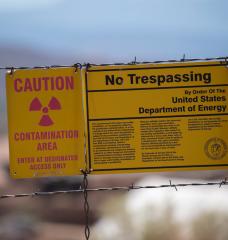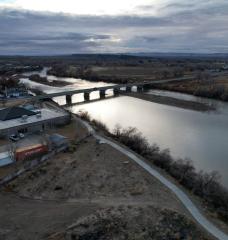Description
Listen on your favorite streaming app.
This season, we’ve talked about alternative energy sources that don’t emit carbon dioxide -- but what if there was a way to continue using fossil fuels for energy without emitting CO2 into the atmosphere? In this episode of TILclimate (Today I Learned Climate), Dr. Howard Herzog and Professor Brad Hager sit down with host Laur Hesse Fisher to talk about capturing, using, and storing carbon emissions, and how it fits into a clean energy future.
Howard Herzog is a Senior Research Engineer in the MIT Energy Initiative (MITEI), where he has researched combating greenhouse gas emissions for over 30 years. He was also a Coordinating Lead Author for the IPCC Special Report on Carbon Dioxide Capture and Storage and a co-author on the MIT Future of Coal Study.
Brad Hager is the Cecil and Ida Green Professor of Earth Sciences in the MIT Department of Earth, Atmospheric, and Planetary Sciences (EAPS). He is also the co-director of the MIT Energy Initiative’s Low Carbon Energy Center on Carbon Capture, Utilization, and Storage.
Season two of TILclimate focuses on our global energy system, its relationship to climate change, and what our options are for keeping the lights on while creating a clean energy future. We're partnering with the MIT Energy Initiative, which will air longer interviews with each guest to take a deeper dive into these topics.
Credits
- Laur Hesse Fisher, Host and Producer
- David Lishansky, Editor and Producer
- Jessie Hendricks, Graduate Student Writer
- Aaron Krol, Contributing Writer
- Ruby Wincele, Student Production Assistant
- Cecilia Bolon, Student Production Assistant
- Skyler Jones, Student Production Assistant
- Music by Blue Dot Sessions
- Artwork by Aaron Krol
Return to TILclimate homepage
Transcript
LHF: [00:00:00] Hello and welcome to TILclimate, the podcast where you learn about climate change from real scientists and experts. I’m your host, Laur Hesse Fisher, with the MIT Environmental Solutions Initiative. We’re back with the next episode in our series on energy and climate in partnership with the MIT Energy Initiative.
So far this season, we’ve talked about ways our electricity system could burn fewer fossil fuels, so the carbon trapped in coal, oil or natural gas stays underground where it can’t warm our atmosphere. But today, we’ll be talking with two members of the MIT Energy Initiative about a technology that actually doesn’t try to replace fossil fuels.
HH: [00:00:50] My name is Howard Herzog. I'm a senior research engineer in the MIT Energy Initiative. In about a month's time I'll be celebrating my 30th anniversary at the Energy Initiative or its predecessor the Energy Lab.
BH: [00:01:05] I'm Brad Hager. I'm a professor of earth, atmospheric and planetary sciences. … And, in addition to being a- a professor, I'm the co-director of the MIT Energy Initiative's Low Carbon Energy Center on Carbon Capture, Utilization and Storage.
LHF: [00:01:21] That’s right, they both work on something called carbon capture, utilization and storage—abbreviated as “CCUS”, or sometimes just called carbon capture, like we’ll call it today .
HH: [00:01:36] The problem for climate change is the emission of CO2 into the atmosphere. So when you burn fossil fuels, you create CO2. The idea in carbon capture is that CO2 that's created by the burning of fossil fuels, you stop from going into the atmosphere. And you do that by capturing it and then you put it somewhere other than the atmosphere.
LHF: [00:02:06] So, why would we even consider this? Well, as we’ve heard earlier in this series, adding clean energy sources like solar, wind, and nuclear, comes with a lot of complications that we need to work out. In theory, carbon capture let’s us use the energy system that we have now, but removes the CO2 emissions from that system.
HH: [00:02:29] The problem with climate change isn't fossil fuels. The problem is the buildup of greenhouse gases in the atmosphere, and so what we want to do is look at solutions that reduce the amount of greenhouse gases we're putting into the atmosphere. If we do that by using less fossil fuels, which I think is going to be part of the solution, so be it, but it doesn't mean that we can't continue to use fossil fuels if we have the technology to use them without putting their emissions into the atmosphere.
LHF: [00:02:58] So today, we’re diving into how carbon capture works, what we’re supposed to do with all this CO2 once we capture it, and just how realistic this is as a way to help slow climate change.
But let’s start with the basics. Because power plants and factories emit so much carbon dioxide in one place, most carbon capture happens there: from the "flue gas" that comes out of their smokestacks. Here’s Prof. Hager.
BH: [00:03:27] The method of capturing carbon dioxide that has been used for the longest is to, run, the flue gas, through a solution of chemicals called amines. The carbon dioxide dissolves in the amines.
HH: [00:03:41] Then you compress it to turn it into basically a liquid, a high pressure liquid. It's technically it's called a super critical fluid but it basically acts like a liquid. and then you can put it in a pipeline and you can put it down a well into the earth. And the place that right now is the biggest opportunity to store the CO2 is in deep underground formations.
LHF: [00:04:08] Engineers look for just the right places to do this so the CO2 can’t leak back into the atmosphere or into our groundwater.
BH: [00:04:17] So we can think of a good reservoir, candidate for storing this stuff as being a layer of shale, called the caprock, to keep the fluids in place. And then underneath it, a layer of sandstone to provide empty space to put the CO2 in.
LHF: [00:04:32] Originally, I imagined these underground caves that the fluid CO2 was poured into. But actually, it’s injected into a rock, which kind of absorbs the CO2.
HH: [00:04:46] The way to think of it is, think of you're at the beach and you have a bucket of sand, and you can put water into it and the water goes in the pores between the sand.
LHF: [00:04:57] The CO2 then sits there, in the same way that oil has been sitting in these kinds of spaces underground naturally for millions of years.
And if this sounds like science fiction, well, actually, it’s already happening. There are around 20 facilities using carbon capture and storage around the world, although most of them aren’t power plants: they’re other industrial plants, like natural gas processors or steel or fertilizer plants. Some of them have been running for a long time.
BH: [00:05:32] The first really serious project is called Sleipner, run by the Norwegians. So in 1996, they started producing sour gas, cleaning it up, removing the carbon dioxide, and injecting it into the subsurface underneath the North Sea. And for the last 23 years, since the plant started, they have been injecting about a million tons of carbon dioxide a year into the subsurface.
LHF: [00:06:03] A million tons of CO2 is about the same amount 200,000 U.S. cars emit in a year. But burying this CO2 is not our only option for dealing with it.
BH: [00:06:16] Recently, there's been a lot of interest in using the carbon dioxide as an intermediate product. It can be used to make plasti cs, make feed stocks for plastics, and it can even be combined with hydrogen to make, for example, jet fuel.
LHF: [00:06:33] The more useful stuff we can make out of CO2, the more reason that companies will have to capture it. Because right now, there isn’t really a big market for this captured CO2.
HH: [00:06:48] The amount of CO2 that we are producing from energy use will - basically is so much larger than markets for a lot of the products people are thinking of that at best it's going to be a niche solution, and you're still going to need to put it in underground reservoirs if carbon capture is going to be adopted on large scale.
LHF: [00:07:05] What does “large scale” really mean? Let’s imagine that we only capture and store one tenth of the CO2 we’re emitting today. That would be about as much liquid as all the oil consumed worldwide—a massive industry served by huge tankers, storage depots, and hundreds of thousands of miles of pipelines.
It would take a lot to repurpose or build new infrastructure for moving around CO2, and if you’re a power company, or a steel manufacturer, you might be wondering why you would pay for it. Which brings us to one of the big challenges for carbon capture: it’s pretty expensive.
BH: [00:07:56] There's additional expense that you need to build the facility to do this. And then it takes energy to do it. So the, increase in, you know, cost of electricity coming down the power line to the consumer, is on the order of 30 to 50%.
LHF: [00:08:13] At the moment, there’s not enough of an incentive for power companies to take on that extra cost.
BH: [00:08:20] In order to promote the capture of carbon dioxide, you need some sort of economic incentive to do that. So you can have a carrot or you can have a stick. And the carrot, which is being held out right now, is the, basically tax rebates.
LHF: [00:08:36] Yeah, actually, here in the U.S., we offer companies a tax credit for capturing their carbon emissions. Right now it's about $50/ton CO2, which isn't really high enough to retrofit all our fossil fuel power plants. So that’s the carrot. And the stick?
BH: [00:08:56] The other side is putting a price on carbon and so if that's high enough, a company will, you know, voluntarily capture and- and sequester its carbon dioxide.
LHF: [00:09:07] We did a whole episode on carbon pricing in our first season, so check that out to understand how a carbon price would work.
The thing you’re hearing here, is that capturing and storing CO2 at our current power plants is possible. But we either need to decrease the costs of doing it or increase the incentives. And the policies we choose can make a huge difference to companies deciding whether to invest in something like carbon capture.
HH: [00:09:39] Technology doesn't happen in a vacuum. Innovation doesn't happen in a vacuum. You need to create the markets and that's a political thing. I think if you had a carbon tax, it will create innovation and there's a lot of room for innovation in this area. But there's no silver bullet in dealing with climate change. There's no one solution that's going to provide the answer.
LHF: [00:10:11] If it becomes cheap enough, carbon capture could be a long-term solution for many power or manufacturing plants. Or its role could be to help us cut emissions immediately until we solve the challenges with wind, solar, or nuclear power, or energy efficiency.
BH: [00:10:30] I see this as a, a strategy that will bridge through the next three decades. And, you know, so the next 20 to 50 years. I hope that cheaper sources of electricity, of clean electricity, will be developed.
LHF: [00:10:44] So carbon capture is one more tool we can add to our clean energy toolbelt. And it’s just like all the other technologies we’ve explored in this series: powerful, but with their advantages and disadvantages, and none of them able to do the job on its own.
There’s a lot more to learn about carbon capture. We’ve left some links in the show notes to places you can learn more, including a couple episodes of the MIT Energy Initiative podcast.
Our next episode of TIlclimate is on fusion energy, so stick with us.
A quick shout out to amyleewee who left us a review on Apple Podcasts. Amyleewee says, “Super informative podcast that breaks down really complex topics into small bites and does so without placing blame! Keep up the good work!” Thanks Amyleewee, we appreciate it.
We invite you to leave us a review on Apple Podcasts as well, or wherever you’re listening from today.
Today I Learned Climate is brought to you by the MIT Environmental Solutions Initiative. Thank you to Brad Hager and Howard Herzog for talking to us, and thank you for listening.
Dive Deeper
For more episodes of TILclimate by the MIT Environmental Solutions Initiative, visit: tilclimate.mit.edu
For related energy podcasts from the MIT Energy Initiative, visit: http://energy.mit.edu.ezproxy.canberra.edu.au/podcast/
For a MITEI podcast discussing carbon capture and more, visit: http://energy.mit.edu.ezproxy.canberra.edu.au/podcast/inside-the-national-energy-technology-laboratory/
Interested in learning more about how carbon capture is used today? Check out the 2019 Global Status of CCS Report from the Global CCS Institute.
If you want to learn about innovative uses for captured CO2, read here about the Carbon XPrize.
For more details on the U.S. carbon capture tax credit mentioned in the episode, see: https://fas.org/sgp/crs/misc/IF11455.pdf
For a deeper dive into the costs of carbon capture worldwide, read: https://www.globalccsinstitute.com/archive/hub/publications/201688/global-ccs-cost-updatev4.pdf
Did you ever wonder what reducing carbon dioxide (CO2) emissions by 1 million metric tons means in everyday terms?
https://www.epa.gov/energy/greenhouse-gas-equivalencies-calculator
In the episode, Laur said storing 10% of the CO2 we’re emitting today would be about as much liquid as all the oil consumed worldwide. Curious how we got that number? See our calculations below:
Professor Hager estimates we emit roughly 400 billion tons of CO2 annually, so 10% would be 40 billion tons.
One compressed ton of CO2 = 46.5 cubic feet = 348 gallons. Here’s where we got these numbers.
This comes to 13,205,060,000,000 gallons of CO2 a year.
The global consumption of oil is about 200 million barrels a day, according to the U.S. Energy Information Administration.
One barrel of oil is 42 gallons.
So that's 1,533,000,000,000 gallons of oil a year worldwide - or very nearly 1/10 of the amount of fluid CO2 we're talking about!
Educator Guide
Carbon capture and storage (CCS) and carbon capture and utilization (CCU) are growing technologies. In a hands-on chemistry lab, students can produce a key ingredient in low-carbon concrete. Through reading, discussion, and data exploration, students investigate the future and potential for CCS as one tool in our toolbox to slow climate change.






